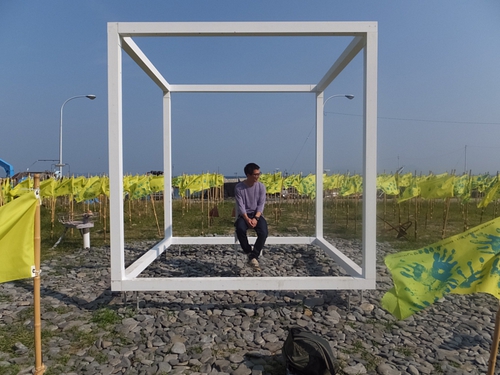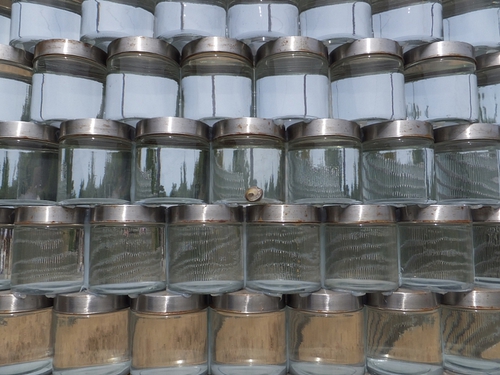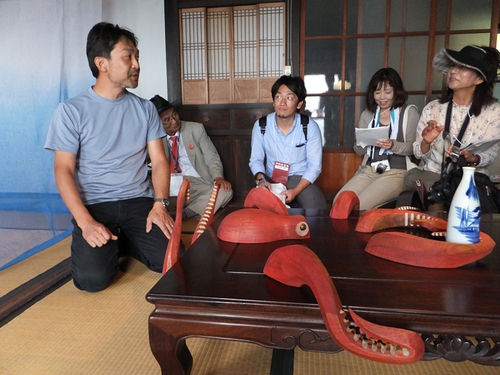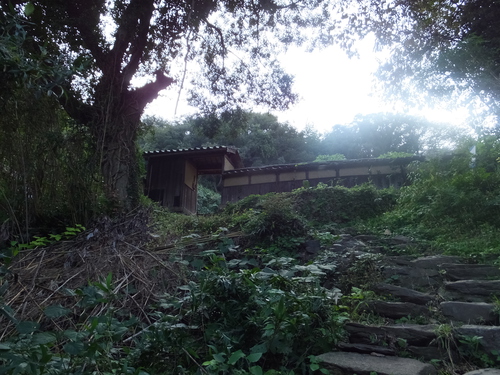2013年11月30日
Takamijima Continued
Here, finally, is my sequel to the article on Takamijima, an island highlighted during the autumn session of the Setouchi Triennale 2013.

Visitors to the island were greeted by yellow flags, perhaps as a reminder of the pyrethrums once cultivated on the hill. Created by several thousand school age children (elementary through senior high) in the Tadotsu district, the flags flapping in the wind sounded like applause.

The settlement of Takamijima dates back to the 12th century when an entire community moved there from Okayama.

As you can see from the photo above, the island is far too steep for farming so why would people have chosen to live there? Perhaps because they could make a good living shipping cargo instead, like residents of so many of the Shiwaku islands.
The island’s shape was captured by Toshiro Komatsu’s “Sea Room”, a 3D rendition of the island using glass jars filled with seawater

and organisms.

Records from 1713 indicate that wooden cargo vessels accounted for 75 percent of the boats on the island whereas only 25 percent were fishing boats. By the late 18th century, however, that had changed, and fishing had become the main industry. That is still true today. The islanders farm Tai (sea bream) and Hamachi (yellowtail). They also catch sea lance and octopi. Ohji Yoshino’s House of Octopus provided a humorous representation of this aspect of island life.


The artist explaining his work.
The steep hill makes the one remaining village a great lookout spot.

Architect Masahito Nomura took advantage of this when he transformed a beautiful old house into a terrace restaurant.

The panoramic view achieved with mirrors was a nice added touch.

The corner tiles on the garden walls were zodiac animal motifs. Although sadly the worse for wear, they were endearing nevertheless, such as this earless hare and hornless ox that appear to be comforting one another.

The house itself was transformed into a gallery


To end our trip, we made a quick dash to the Itamochi Village Restoration Project, a 10-minute bike ride and 5-minute very steep hike. The last person living in this village left 7 years ago, and the project was a forewarning of what may lie ahead for the other village.

As we were leaving, however, a staff member told us that despite the island’s rapidly dwindling population, the islanders have decided to participate in the next Triennale in 2016. A small ray of hope for the village.

Takamatsu Access:
Takamatsu can be reached by direct flights from Tokyo’s Haneda Airport, by express bus from Kansai International Airport (3 hr), and by direct flights from China and Korea. It can also be reached by taking the bullet train to Okayama and changing to the Marine Liner bound for Takamatsu (runs every 1/2 hour; takes 1 hour). For more info see http://wikitravel.org/en/Takamatsu
タグ :Takamijima
Posted by cathy at
00:44
│Comments(0)
2013年11月28日
Magic Gold
If you’ve read this blog before, you will know that I love Ritsurin, a traditional Japanese garden covering 75 hectares in the middle of Takamatsu. At this time of year, Ritsurin hosts its autumn leaf viewing festival, an event that has continued for the last 12 years.
The garden is illuminated until 9PM, allowing visitors to enjoy the beauty of the colored leaves and deep green evergreens shimmering in the night.


On the weekend, concerts and food stalls add to the festivities. This year the festival runs until Sunday evening, December 1. If you have the chance to go, I highly recommend it. While you're there, take a punt ride on the pond.
As a Ritsurin Garden fan, it is always a delight to discover something new. My latest find is those jagged rocks sticking out of the pond in the far left of the photo below.
Those are no ordinary rocks. Traditional Japanese garden design was heavily influenced by the Chinese, and Ritsurin likewise contains many allusions to Chinese philosophy. Those rocks represent an island located far across the sea, which in ancient Shinxian mythology was believed to house immortals. Twice a year—a month before the winter solstice and a month after—these stones turn to gold.
This phenomenon was first noticed by volunteer guides while taking visitors across the bridge just as the sun was sinking behind the hill. Hearing cries of surprise, they turned to see the rocks shining like gold. Rumors of this phenomenon began spreading about 4 years ago, but not many people manage to be in the right place at the right time. The foot of an ancient tree in the teahouse garden also turns gold.
This little bit of magic is caused by a glass covered building outside the park. At just the right time of year, it catches the rays of the sinking sun and reflects gold light into the garden. I have always thought the few buildings visible from the garden ruin the view. Although I still hope that they will be removed some day, twice a year I will forgive them for being there. This special “light show” lasts only 4 minutes and occurs around November 22 and January 22 between 3:30PM and 4 PM.
(Many thanks to Hiroko who caught the "show" on camera.)
Takamatsu Access:
Takamatsu can be reached by direct flights from Tokyo’s Haneda Airport, by express bus from Kansai International Airport (3 hr), and by direct flights from China and Korea. It can also be reached by taking the bullet train to Okayama and changing to the Marine Liner bound for Takamatsu (runs every 1/2 hour; takes 1 hour). For more info see http://wikitravel.org/en/Takamatsu
タグ :Ritsurin Garden
Posted by cathy at
23:02
│Comments(0)



